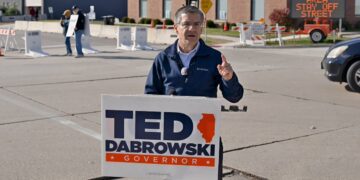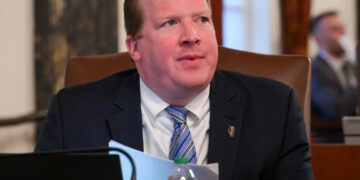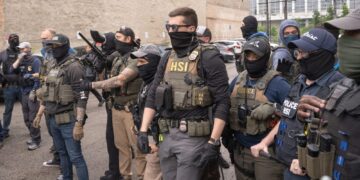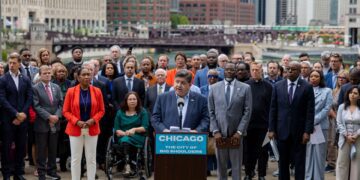By John F. Di Leo -
What have we learned, in the weeks since the Valentine’s Day massacre in Parkland, Florida?
We have seen the same well-intentioned but utterly misguided efforts that we always see after such horrors: a focus on banning one weapon out of many, as if that would make a difference, while closing our eyes to the real perpetrators and the actual causes of vulnerability. But we are used to that.
What we are unused to, however, is the removal of the façade that for so long as hidden the Left’s efforts at the banning, and even outright confiscation, of firearms from law-abiding citizens.
For decades, the Left claimed to only want to make it harder, and preferably impossible, for bad people to get guns – who could argue with that goal? For decades, they claimed that the Right’s fear – that outright confiscation was in the Left’s sights – was nothing but paranoia.
They no longer attempt to con us with such lies; since Parkland, the truth is out.
Solutions Have No Place.
In the days following the massacre, wise counselors again called for the measures that we all know are needed, such as these:
- An end to the suicidal idea of the gun-free zone, in which, by design, only lawbreakers would be armed…
- The encouragement of willing and trained school staff to utilize concealed carry for the defense of the innocent…
- A change in the way that we design schools, to integrate the security methods that are built into the design of every other public building, but have purposefully been resisted in education…
- Rational attention to the dangers of the criminally insane, and the need to make careful commitment of such persons less of an impossibility…
- The encouragement of cooperation between schools and law-enforcement…
- Cooperation in full utilization of the national criminal background check system.
But voices advocating such things have been forcefully muted. Voices calling for rational improvement in these areas have been kept off the stage, kept off the airwaves, kept out of the public debate.
Instead, the American Left has dominated each news cycle with a full-court press for gun bans… even to the point of billing a Washington DC march – the “March for our Lives” – as “a high schoolers’ demonstration,” when in fact fewer than 10% of the attendees were even of high school age.
It no longer surprises us to learn that the mass media have become little more than a vast public relations firm for leftist politics… but even to this jaded nation, the extent of their submission to the orders of George Soros and his fellow travelers is shocking.
Slowly, quietly, school districts are talking about allowing their teachers with concealed carry authority to protect their classrooms; slowly, quietly, such teachers are speaking up at school board meetings and city council sessions, even running for public office to force the consideration of measures that concentrate on punishing the law-breakers instead of restricting the law-abiding.
But such genuine improvements in the security of our schools get little press, and in fact conflict with the official position of the pop culture that now controls the press, the academe, and so much of our politics. The message of the day is clearly that “society is not interested in a solution; we’re after your guns.”
The Honesty of Associate Justice Stevens
To the shock of most onlookers, retired Supreme Court Justice John Paul Stevens penned a fascinating piece in the New York Times on March 27, one that blew the lid off the long-denied true goal of the anti-gun Left:
While parroting many of the falsehoods of his side of the aisle – such as the ludicrous claim that the right to bear arms doesn’t apply to American citizens – it was at least honest in two aspects: Justice Stevens acknowledged that, yes indeed, the Left really does want to ban the private ownership of firearms, and that, yes indeed, repeal of the Second Amendment would be necessary for them to accomplish this goal.
This honesty has helped the debate. It brings to an end the half century of denials by the Left of their true goal, and for this we should be grateful. No more can the Right be called paranoid: the truth is out at last.
The evidence doesn’t change at all. The Right’s position – that firearms in the hands of law-abiding citizens are a blessing, not a curse – remains the correct position, with both statistics and philosophy on its side. Firearms in the hand of the law-abiding stop more crimes every day than are used in their commission. Just knowing that some potential marks are themselves armed dissuades would-be muggers and rapists every day, and as concealed-carry becomes more and more popular, it convinces more and more such criminals to give it up, and go into a safer line of work.
But there is one more point that needs to be mentioned, and oddly, it is one that never is. We need to discuss the nature of the goal of that Constitutional Amendment battle that Justice Stevens proposed.
Justice Stevens rightly points out that repeal of the 2nd would be needed to ban guns… and the Right rightly points out that such a repeal would be a very steep climb indeed, considering the philosophical makeup of the fifty states.
But what few consider is the special nature of the Bill of Rights, as distinguished from the rest of the Constitution. Amending the original seven articles was an ability envisioned from the very beginning; amending the amendments from the eleventh on was equally anticipated.
We designed a system for choosing president and vice president in Article II, then modified it in Amendments XII, XXII, and XXV. We passed a nationwide ban on alcohol in Amendment XVIII, then reconsidered, and undid that ban in XXI.
But only the utter lack of knowledge of American History that has imbued American education’s march to mediocrity over the past half century can explain the popular culture’s inability to see that the Bill of Rights is a completely different animal from both what precedes and follows it in this august document.
The Bill of Rights
At the Constitutional Convention, held at Independence Hall in Philadelphia during the summer of 1787, a select group of our Founding Fathers, known today as The Framers – met to design a better government than the Articles of Confederation had provided. While the former document had zealously protected the nation from too strong a central government, in many ways, it wound up protecting the nation from any effective government at all, while enabling the individual states to act as fatal obstacles to the commerce of their neighboring states.
The new document, the Constitution of the United States, sought to rectify these errors, cementing the states as allies in a single union, and providing the nation with just enough of a national government to ensure a stable currency, a legal structure, a common defense, a postal service, and the conditions necessary for international trade.
Among the group were delegates who had been involved in the drafting of their respective states’ constitutions during the War of Independence, each of which boasted a Bill of Rights – a list of specific inalienable individual human rights, which government could and should protect, and which government is specifically barred from ever infringing upon itself.
A free citizen has a right to meet with his neighbors, to choose his religious denomination, to speak about politics in the public square or comment about politics in print. A free citizen has a right to his property; government cannot take his goods or land without fair compensation. A free citizen has a right to a speedy trial if accused, by a jury of his peers if he desires it, and to be free of any risk of torture as part of his punishment. And in some ways the most important of all, a free citizen has the right to keep and bear arms.
When the Constitutional Convention completed its business, the delegates decided that a Bill of Rights – critical in so many other contexts – was unnecessary here. The delegates decided that a government already limited in its very construction needed no further list of bans, because after all, any action at all, not authorized in the seven articles, was already banned, by definition. Unaccepting of such reasoning, Virginia delegate George Mason stormed out and refused to sign, and it soon became clear that he spoke for a majority of the states.
Otherwise splendid though this new Constitution was – so thoughtfully conceiving the concept of “shared sovereignty” to safeguard the rights and powers of the states, the nation, and the individual; so carefully setting the three branches as counterbalances to each other, and brilliantly designing the Senate to serve as the several states’ critical brake on all the others – this lack of a Bill of Rights was deemed a fatal flaw.
One by one, the states spoke: we will ratify this brilliant document on one condition – that a bill of rights be added to it, and soon. They knew the urgency of the mission; they didn’t hold up ratification for it. The Articles needed to be replaced, ASAP. But they made it clear to every politician who sought state or federal office: they had better undo this error.
The Federalists – those advocates of the Constitution who shepherded the effort through the ratification process, state by state – accepted the demand and began to work on it. In the first Congress, James Madison and his colleagues gathered the Bills of Rights of the various states and crafted a fresh list that would keep this promise. And so we have this Bill of Rights, these ten amendments, proposed in the first year of the first Congress, in 1789, and ratified by the states by the end of the first year of the second Congress, in 1791.
These ten amendments occupy a special place in American law. It’s not just that the Bill of Rights was the first set of amendments, and it’s not just that they were crafted by the Founding Fathers.
It’s that they were a condition of the Constitution’s ratification itself. This sets the Bill of Rights apart from all the rest.
The Bill of Rights – all ten, not just bits and pieces of a few of them, but the entire list – constitute a declaration by the people of America to their government and to their world: These are individual human rights, which government is established to protect, and upon which government must certainly never intrude.
These ten amendments act as a set, declaring that government is of no use unless it protects these rights… not just some, but all of them.
Whether one lives in a time in which the jury process is abused, or freedom of speech is curtailed, or a greedy government tries to grab our land or our bank accounts or our guns, the entire list is sacrosanct, for all eternity. Each one is a constant reminder of the importance of the rest.
There are religious people who fear persecution… residents of dangerous neighborhoods who know the police are too few and too far to protect them… vocal statesmen with minority opinions… state legislators and governors who fear the tyranny of federal overreach. As long as we view the Bill of Rights as a set, everyone protected by any of these ten amendments will stand up for the authority of all ten… knowing that if we allow the one most important to our neighbor to be abused, the one most important to each of us might well be next.
Care about your freedom of speech? Care about your right to go to the church or synagogue of your choice? Care about your farm, your ranch, your condo or your home?
Then support the right of your neighbor the firearm-owner as well. Just as his choice to be one of those concealed-carrying permit holders on the city streets keeps you safe at night without your knowledge, just by being one of the statistic that dissuades a mugger or rapist from plying his trade, his support of the Bill of Rights also protects the rights to write and talk, to pray and travel, to own property and to do business, that you count key to your life as an American freeman.
The Bill of Rights is a set. It was and remains the essential condition of the establishment of our government in its constitutional form.
If the Bill of Rights is ever broken up… if a foolish electorate, succumbing to the voices of demagogues and the corrupt funding of foreign NGOs, starts abandoning these rights that our Founding Fathers knew were imperative to proper and legitimate governance, then our very system will have been shaken at its foundation, with its eventual collapse the only possible result.
In short, if the Second Amendment ever falls, it will soon be followed by the rest… and the United States of America will be no more.
Copyright 2018 John F. Di Leo
John F. Di Leo is a Chicagoland-based international trade compliance trainer, writer, and actor. His columns regularly appear in Illinois Review.
Permission is hereby granted to forward freely, provided it is uncut and the IR URL and byline are included.







